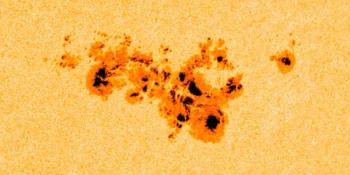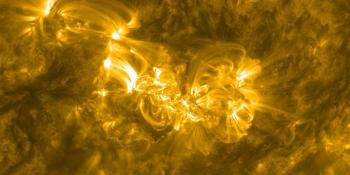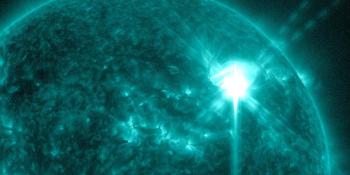Viendo archivo del sábado, 5 febrero 2011
Informe actividad solar
Any mentioned solar flare in this report has a scaling factor applied by the Space Weather Prediction Center (SWPC). Because of the SWPC scaling factor, solar flares are reported as 42% smaller than for the science quality data. The scaling factor has been removed from our archived solar flare data to reflect the true physical units.
Informe de actividad Solar-Geofísica 2011 Feb 05 2200 UTCPreparado por NOAA © SWPC y procesado por SpaceWeatherLive.com
Informe conjunto USAF/NOAA de actividad Solar y Geofísica
SDF Número 036 Publicado el 2200Z a las 05 Feb 2011IA. Análisis de regiones solares activas y de actividad desde 04-2100Z hasta 05-2100Z Solar activity has been very low for the past 24 hours.
Region 1152 (S18W14) and Region 1153 (N15W31) have begun to decay
with a loss in areal coverage, magnetic complexity, and a reduced
sunspot number. Region 1150 (S20, L=187) decayed to spotless plage
early in the period.
IB. Pronóstico de la actividad solar
Solar activity is expected to be very
low with a slight chance for C-class activity for the next three
days (06-08 February).
IIA. Resumen de la actividad geofísica 04-2100Z a 05-2100Z
The geomagnetic field has been at quiet to active levels with an
isolated period at G1 ,minor storm levels, from 4/2100Z-4/2400Z.
This increase in activity was associated with a reverse shock behind
a slow moving CME observed on 30 January. Observations from the ACE
spacecraft indicated the effects of the shock subsided around
4/0421Z, as a recurrent coronal hole high speed stream, in which the
CME was embedded, regained dominance. Throughout the period, the
total Interplanetary Magnetic Field (IMF) decayed from 17 nT at
04/2106Z to 3nT at 05/2008Z. Solar wind speeds peaked at around 675
km/s at 05/0536Z, but speeds began to decrease as the day
progressed.
IIB. Pronóstico de la actividad geofísica
The geomagnetic field is
expected to be quiet to unsettled for the next two days (06-07
February) as the effects of the latest recurrent coronal hole high
speed stream wane. A return to quiet levels is expected on day three
(08 February).
III. Probabilidades del evento 06 Feb a 08 Feb
| Clase M | 01% | 01% | 01% |
| Clase X | 01% | 01% | 01% |
| Protón | 01% | 01% | 01% |
| PCAF | Green | ||
IV. Penticton 10.7cm flujo
Observado 05 Feb 081 Previsto 06 Feb-08 Feb 080/080/080 Media de 90 Días 05 Feb 084
V. Índices Geomagnéticos A
Observado Afr/Ap 04 Feb 012/021 Estimado Afr/Ap 05 Feb 015/018 Previsto Afr/Ap 06 Feb-08 Feb 008/010-008/008-005/005
VI. Probabilidades de Actividad Geomagnética 06 Feb a 08 Feb
| A. Latitudes Medias | |||
|---|---|---|---|
| Activo | 20% | 20% | 05% |
| Tormenta Menor | 05% | 05% | 01% |
| Tormenta Mayor-Severa | 01% | 01% | 01% |
| B. Latitudes Altas | |||
|---|---|---|---|
| Activo | 25% | 25% | 10% |
| Tormenta Menor | 10% | 10% | 01% |
| Tormenta Mayor-Severa | 01% | 01% | 01% |
< < Ir a la visión general diaria
Últimas noticias
Últimos mensajes del foro
[CME] AR 13664, flare flurry, CMEs galore, 2024-05-08/09 198Filaments and prominences 89Is there any truth to this "Internet/Electrical Grid Apocalypse"? 105Incoming Active Regions 243AR3664 675
Más temasApoye a SpaceWeatherLive.com!
Mucha gente viene a SpaceWeatherLive para seguir la actividad del Sol o previsión de aurora, pero con esta cantidad de tráfico se incrementan los costos del servidor. ¡Considere hacer una donación si disfruta de SpaceWeatherLive para que podamos mantener el sitio web en línea!

Hechos clima espacial
| Último evento clase X | 2024/05/10 | X3.8 |
| Último evento clase M | 2024/05/10 | M1.3 |
| Últimas tormentas geomagnéticas | 2024/05/06 | Kp5 (G1) |
| Días sin manchas | |
|---|---|
| Último día sin manchas | 2022/06/08 |
| Promedio de manchas solares mensuales | |
|---|---|
| abril 2024 | 136.5 +31.6 |
| Last 30 days | 167.9 +77.8 |


